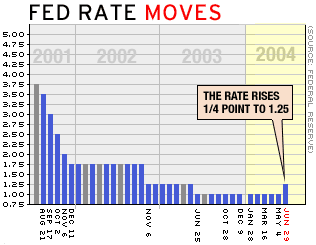NEW YORK (CNN/Money) -
The Federal Reserve raised its target for a key short-term interest rate a quarter-percentage point Wednesday, the first increase in nearly four years in a move probably marking the end of super-low rates in the United States.
In a statement announcing its decision, the Fed said it expected inflation to stay "relatively low," meaning the central bank could take its time raising rates further, but it also pledged to move more quickly if economic numbers called for it.
At the end of a two-day policy meeting, the Fed's policy-makers raised their target for the fed funds rate, an overnight lending rate that influences other rates throughout the economy, to 1.25 percent from 1 percent, which had been the lowest level in more than 40 years. It was the first such increase since May 2000.
In its closely watched statement, the Fed's policy committee noted the "solid pace" of economic expansion, including "improved" labor market conditions, but made fairly sanguine comments about inflation, which has shown signs of accelerating recently.
"Although incoming inflation data are somewhat elevated, a portion of the increase in recent months appears to have been due to transitory factors," the Fed said, likely referring to recent spikes in food and energy prices.
With that in mind, the Fed said again that it could be "measured" in raising rates in the future.
In the last sentence of its statement, however, it added that it was willing to move more aggressively if inflation data warranted it.

"The central bank put itself in a box with the top lid open so that it can change its policy quickly in response to changing economic conditions," said Sung Won Sohn, chief economist at Wells Fargo.
The Fed raises rates when it wants to fight inflation and cuts rates when it wants to stimulate the economy.
Stock prices, which had traded lower for most of the day, reversed course and edged higher after the decision.
The mild hike and dovish comments about inflation also helped boost Treasury bond prices, sending yields lower. Bond prices and yields move in opposite directions.
"They are a bit more sanguine about inflation than the market has been, and they've been trying to tell people that," said Joshua Feinman, chief economist with Deutsche Bank Asset Management. "It doesn't mean they have their head stuck in the sand. With the last sentence of their statement, they leave themselves plenty of flexibility."
First in a series
To fight the effects of the 2001 recession, the Sept. 11 terror attacks, two wars and a prolonged labor-market slump, the Fed cut rates 13 times between 2001 and 2003.
| 
| |

| 
| 
|

|
 Now that the Fed has raised interest rates by a quarter of a point, CNNfn's Gerri Willis tells you what the rate hike means for consumers. Now that the Fed has raised interest rates by a quarter of a point, CNNfn's Gerri Willis tells you what the rate hike means for consumers.
|
 Play video
Play video
(Real or Windows Media)
|
| 
|

|
|
The super-low rates fueled a boom in housing demand and in mortgage refinancing. As homeowners locked in lower rates, they cut their monthly bills and were able to transform home equity into spending cash, which kept the struggling economy afloat.
But several straight months of economic expansion, along with three straight months of robust job growth, have convinced many observers this year that inflation is a growing risk, especially with the fed funds rate still below the rate of inflation -- rocket fuel to the economy.
"The core consumer price index (CPI) has risen by 3.3 percent annualized over the past three months," said Steve Stanley, economist with RBS Greenwich Capital. "We'd all better hope that some of this is 'transitory.'"
Certainly, if core CPI and other measures of inflation keep accelerating at such a pace, the Fed's next move, at its policy meeting scheduled for August, will be more aggressive.
"I think the Fed opened the door for a half-percentage-point increase in August, if it's needed," said former Fed Governor Lyle Gramley, now a consulting economist with Schwab Washington Research.
Inflation -- or slowdown?
To reassure markets that they're keeping an eye on inflation, Fed officials have spoken often about the need to raise the fed funds rate to a more neutral level. In Wednesday's statement, they acknowledged that a 1.25 percent fed funds rate "remains accommodative."
Thus, Wednesday's move was likely just the first of a series of hikes that could take the fed funds rate to 2.25 percent by the end of the year and, some analysts believe, to 3 or 4 percent next year.
On the other hand, recent data have hinted that the economy, which grew in the third quarter of 2003 at its fastest pace in 20 years, may have peaked. The growth rate has slowed in each quarter since, gauges of manufacturing activity have cooled and retail sales were weak in June.
Meanwhile, though recent strong job growth has lifted consumers' spirits, it hasn't done quite as much for wages, and it hasn't brought the unemployment rate down much, meaning the economy still may have plenty of "slack," which would tend to help keep inflation in check.
Few are predicting a recession, but the economy might not run hot enough this year to inspire much aggression on the part of the Fed.
"The Fed's tightening campaign should not be interpreted as an attempt to brake an out of control economy," said Richard Yamarone, director of economic research at Argus Research.

|